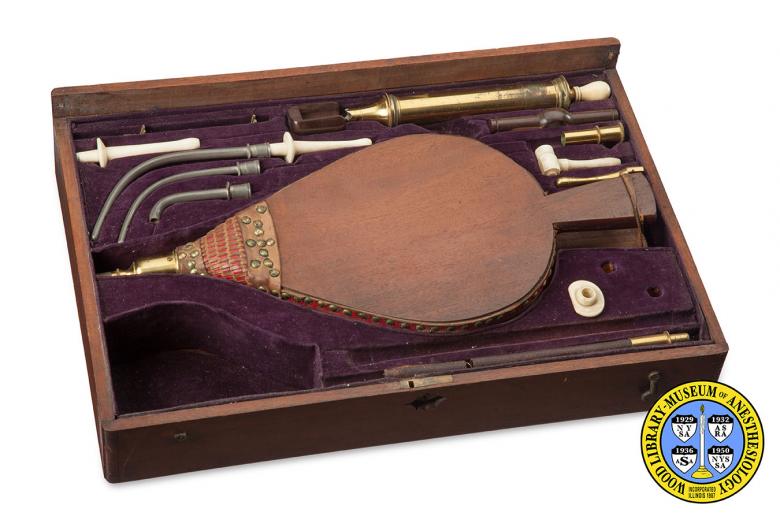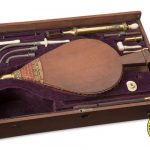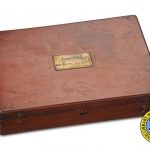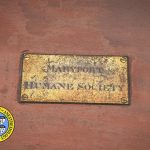Tobacco Resuscitator
Since prehistoric times many methods have been tried to revive persons who have stopped breathing. The Society for the Recovery of Persons Apparently Drowned was founded in London in 1774. Later known as the Royal Humane Society, branches were established in many coastal towns. This resuscitation apparatus, approved by the Society, was probably owned by a branch in Maryport, England. It includes pieces for forcing air through the mouth or nose, administering medicines into the stomach, and injecting tobacco juice and smoke rectally.
One of the Society's aims was to share information about resuscitation techniques. Among the first methods to be adopted was the "tobacco smoke enema". This Native American practice had been reported by European settlers in the New World. Tobacco juice and smoke are highly irritating to the body's internal passages. Forced from a bellows, through the anus, and into the rectum, the smoke was expected to warm and stimulate the victim. By the late 1830s the rectal technique had fallen out of favor, but the use of irritating fumes for respiratory therapy continued for over a century.
Mouth-to-mouth breathing was another method that was tried and abandoned, until the modern technique of Cardiopulmonary Resuscitation (CPR) was introduced in the late 1950s. Today, anesthesiologists are responsible for resuscitating the patient if that is needed during surgery.
Catalog Record: Tobacco Resuscitator
Access Key: akir
Accession No.: 2012-07-11-1
Title: The Humane Society’s [apparatus for resuscitation].
Title variation: Alt Title
Title: Apparatus for the resuscitation of persons apparently drowned.
Title variation: Alt Title
Title: Royal Humane Society’s apparatus for the resuscitation of persons apparently
drowned.
Title variation: Alt Title
Title: Tobacco resuscitator.
Title variation: Alt Title
Title: Royal Humane Society case of apparatus for resuscitation.
Publisher: 1782-1837.
Physical Descript: 1 resuscitation kit ; wood, metals, ivory, leather, textiles ; 10 x 44 x 29
cm.
Subject: Resuscitation – instrumentation.
Subject: Resuscitation – history.
Subject: Respiration, Artificial – instrumentation.
Subject: Tobacco – therapeutic use.
Note Type: General
Notes: The early year [1782] in the date range for the possible year of manufacture
is based on the year that the Royal Humane Society began to recommend bellows
as the best means for artificial respirations (Meltzer, 1917). Because the
year that the society stopped stocking “clyster-pipes” (attachments for
insertion into the anus for the administration of enemas) in its cases of
resuscitation apparatus is unknown, the end date is based on the year that
the society ceased recommending the use of bellows (1837). The case
illustrated in the society’s 1823 report contains a “flexible bottle” rather
than a syringe for the administration of cordials or stimulants into the
stomach. This may be an indication that this case was manufactured before
1823. Also metal plate on the wooden case is marked with, “MARYPORT HUMANE
SOCIETY”. Whether the fact that the word “Royal” is not included is
significant to the date (pre-1787?) of the case and its contents is unknown.
The date range could change if documentation indicates the range should be
corrected.
Note Type: General
Notes: Title based on the metal plate affixed to the lid of the base and on the
earliest publication of the society in which a case or set of its apparatus
was found to be referred to. This was the Society’s 1808 Annual Report, page
43.
Note Type: General
Notes: The few detailed descriptions of apparatus supplied or recommended by the
Humane Society describe the case being lined with “baize” (a coarse,
felt-like, woolen material that is typically green, used for covering
billiard and card tables). This case is lined with dark purple velvet.
Note Type: Citation
Notes: Annual Report of the Royal Humane Society for the Recovery of Persons
Apparently Dead. London: The Society; 1816. https://woodlibrarymuseum.
org/library/pdf/S_AFBY.pdf. Accessed August 23, 2013.
Note Type: Citation
Notes: Eisenber MS. The search for artificial respiration. Life in the Balance:
Emergency Medicine and the Quest to Reverse Sudden Death. New York: Oxford
University Press; 1997:59-64.
Note Type: Citation
Notes: The Forty-Ninth Annual Report of the Royal Humane Society for the Recovery of
Persons Apparently Drowned or Dead. London: The Society; 1823.
https://woodlibrarymuseum.org/library/pdf/S_ACSD.pdf. Accessed August 23, 2013
Note Type: Citation
Notes: Hawes W. Royal Humane Society. Annual Report. London: The Society; 1808:38-90
https://books.google.
com/books?id=AXtbAAAAQAAJ&pg=PA43&dq=explanation+Royal+Humane+Society%27s+App
ratus&hl=en&sa=X&ei=U3wbUvCEGKes2wXvtoCIBw&ved=0CDgQ6AEwAA#v=onepage&q=explan
tion%20Royal%20Humane%20Society%27s%20Apparatus&f=false. Accessed August 26,
2013.
Note Type: Citation
Notes: Haynes S. Tobacco smoke enemas. B C Med J. 2012;54(10):496-497.
Note Type: Citation
Notes: Humane Society, For the Recovery of Persons Apparently Dead by Downing.
[London]: [The Society]; [1783?]. https://books.google.
com/books?id=7DcXAQAAIAAJ&printsec=frontcover#v=onepage&q=Humane%20Society&f=
alse. Accessed August 23, 2013.
Note Type: Citation
Notes: Huston KG. Introductory notes. In: Resuscitation: An Historical Perspective.
Park Ridge, IL: Wood Library-Museum; 1976:1-3.
Note Type: Citation
Notes: Meltzer SJ. History and analysis of the methods of resuscitation. Med Rec.
July, 1917;92(1):1-4.
Note Type: Citation
Notes: Notable dates. Royal Humane Society website. https://www.royalhumanesociety.
org.uk/html/key_dates.html. Accessed August 24, 2013.
Note Type: Citation
Notes: Reports of the Humane Society. London: The Society; 1784. https://books.google
com/books/about/Reports_of_the_society.html?id=WbwpAAAAYAAJ. Accesed August
23, 2013.
Note Type: Citation
Notes: Royal Humane Society. Cottager’s Mon Visit. July, 1831;11:301-303.
https://books.google.
com/books?id=n9cEAAAAQAAJ&printsec=frontcover&dq=editions:KGe0wnnwr7YC&hl=en&
a=X&ei=eG8bUqiuFIfI2gWm5oGgBQ&ved=0CDYQ6AEwAjgU#v=onepage&q&f=false. Accessed
August 26, 2013.
Note Type: Physical Description
Notes: One wooden case containing apparatus for resuscitation; It is lined with
purple velvet and has numerous compartments shaped for the various pieces of
equipment; A bellows made of wood, leather and brass is the largest object in
the case, measuring approximately 44 cm in length, and 18.3 cm at the widest
point; In the wood of one side of the bellows is a hole that measures
approximately 3 cm in diameter; Two curled tubes, made of leather or a
textile, and coated with a substance to render them impermeable, are stored
under the bellows; The are about 1 cm in diameter; One of the tubes has brass
tubes affixed to each end; The brass tubes measure approximately 9 and 11.5
cm in length; In total this tube measures approximately 45 cm in length; The
other tube has a rounded blind tip with two eyelets, approximately 1.5 and 2.
5 cm from the very tip; This tube has an approximately 6 mc brass rube
affixed to the other end; In all this tube measures approximately 71.5 cm in
length; In a slot next to the bellows is a straight tube made of the same
material as the two tubes previously described; It is cracked into two pieces
(one shorter than the other) but held together by an inner spiraled coil of
metal; One end is torn or has also broken; On the other end is a brass tube
that measures approximately 4.5 cm in length; In total the tube measures
approximately 22 cm in length; The second largest piece in the case is a
brass syringe with an ivory knob on the end of the plunger handle; With the
plunger extended the syringe measures approximately 30.5 cm in length; The
main body of the syringe measures approximately 2.5 cm in diameter; There is
an oval whole in the body of the syringe close to the nozzle end; Within the
nozzle are pieces for a valve to prevent aspiration of injected substances
when the plunger is pulled back; The end of the nozzle has two grooves for a
brass wrench that is also in the case; The nozzle is threaded and can be
screwed on and off; The very tip of the nozzle ends in a dramatic scalloped
pattern; Also contained in the case are two curved metal tubes intended to be
inserted down the throat and beyond the glottis (intralaryngeal tubes); Both
intralaryngeal tubes are quite narrow (less than a cm in diameter); One of
the intralaryngeal tubes measures approximately 18 cm in length and the other
approximately 14 cm in length; Both have rounded blind tips with two eyelets
5 to 2 cm above the tip; There is one curved metal tracheal tube with two
wings with small holes near the distal end for suturing and securing to the
skin; The tracheal tube measures approximately 8 cm in length and is open at
the end; The case also contains one ivory “nostril-pipe”, and two empty slots
for nostril-pipes that are missing from this kit; There are two ivory
insertion tubes that are likely to be “clyster-pipes” for the administration
of enemas; One measures approximately 8.5 cm in diameter and the other
approximately 9 cm in length; There are two unidentified wooden pieces and
one unidentified ivory piece that resembles a small tobacco pipe; One end is
threaded on the inside as if it is meant to screw onto another piece; There
is also an unidentified brass tube that is also threaded on the inside at one
end; It could have been an end for the broken straight tube, or a tube not
present; There is a slot with metal clips to hold an instrument that is
missing; based on the shape of the slot and the clips it is possible that it
once held a scalpel for performing tracheotomies; There is a larger
irregularly shaped space or another missing piece or pieces of equipment –
possible what was called the “smoke box” or the container for administering
“stimulating substances”; There are two or three other spaces that may have
one held other pieces of the kit; The lid of the case is detached; On the
underside it is lined with padded purple velvet; On the center of the
exterior of the top of the case is a metal plate marked with, “MARYPORT
HUMANE SOCIETY”.
Note Type: Reproduction
Notes: Photographed by Mr. Steve Donisch on January 17, 2013.
Note Type: Historical
Notes: Prior to the late 1700s coordinated systems for the resuscitation of
individuals who died suddenly were non-existent. Most people knew very little
about the body’s functions, and were on their own if someone near them was
drowning, choking or suddenly stopped breathing for any reason. Organized
efforts aimed at resuscitation began during the 1760s and 1770s with the
formation of societies ‘for the recovery of persons apparently drowned’ in
major European, and a few American, cities. In England the organization came
to be called the Royal Humane Society. Its mission included the dissemination
of the knowledge and skills required to rescue drowned individuals, and the
provision of equipment and trained volunteers. In addition to water-rescue
devices such as life preservers, drag-poles and ropes, the Society supplied
or encouraged the purchase of wooden cases stocked with resuscitation
apparatus, like the case described here.
Knowledge of human physiology had not progressed enough to distinguish
promising resuscitation techniques from interventions that seem utterly
bizarre to us today. Along with yelling and shaking a victim in an attempt to
elicit a response, warming the victim and performing artificial respiration
(breathing), rescuers might also have attempted bloodletting (piercing a vein
and draining a certain amount of the patient’s blood), inversion (hanging the
drowned person upside-down), and fumigation (blowing tobacco smoke into the
rectum).
Sometimes called tobacco resuscitation or a tobacco enema, the idea came from
reports of this practice by Native Americans. It was thought that the
tobacco smoke was a strong stimulant, and for a number of decades rescuers
were encouraged to repeatedly blow tobacco smoke into the rectum of
individuals who had downed.
As reflected in the array of apparatus contained in the society’s case,
fumigation was not the only intervention rescuers were encouraged to perform.
The bellows were also used to administer rescue breathing, or artificial
respirations. In addition to the attachments for administering enemas, the
cases contained ivory “nostril-pipes”, long curved metal tubes to insert into
the mouth and throat, and a tube that could be inserted into the trachea
(wide-pipe) through an incision made in the neck. The cases also provided a
large metal syringe or compressible bottle and a long flexible tube for
injecting medicinals into the stomach.
In order to determine what methods were and were not effective, the Society
encouraged scientific investigations into the matter, and kept records on all
of the rescue attempts reported to them. When the Society modified its
recommendations, new instructions were published in an annual report, and at
least a few times in printed “pocket companions” for quick reference.
Tobacco resuscitation fell out of favor during the first few decades of the
19th century, but not before tobacco enemas had been used as a cure-all for
ailments ranging from constipation and headaches to typhoid fever and
end-stage cholera.
Note Type: Publication
Notes: Baker AB. Artificial respiration, the history of an idea. Med Hist.
1971;15(4):336-351.
Note Type: Publication
Notes: Davidson LAF. Founders and benefactors of the Royal Humane Society (act.
1774–c.1808). Oxford Dictionary of National Biography website.https://www.
oxforddnb.com/templates/theme-print.jsp?articleid=101001. Accessed August 23,
2013.
Note Type: Publication
Notes: The Forty-Eighth Annual Report of the Royal Humane Society for the Recovery
of Persons Apparently Dorwned or Dead. London: The Society; 1822.
https://woodlibrarymuseum.org/library/pdf/S_ACSC.pdf. Accessed August 23, 2013
Note Type: Publication
Notes: France EM. Some eighteenth century authorities on the resuscitation of the
apparently drowned. Anaesthesia18 xm at the widest point1975;30(4):530-580.
Note Type: Publication
Notes: Howard B. The direct method of artificial respiration for the treatment of
persons apparently dead from suffocation by drowning, or from other causes.
In: Transaction of the American Medical Association. Vol. 22. Philadelphia:
The Association; 1871:312-352. https://books.google.
com/books?id=Xe1XAAAAMAAJ&printsec=frontcover&dq=editions:gAin1HBZCZoC&hl=en&
a=X&ei=G0UaUrDNNqeL2AX56ICoBA&ved=0CDIQ6AEwAQ#v=onepage&q&f=false. Accessed
August 23, 2013.
Note Type: Publication
Notes: Keith A. Three Hunterian lectures on the mechanism underlying the various
methods of artificial respiration practiced since the foundation of the Royal
Humane Society in 1774. Lancet. March 13, 0909;173(4463):745-749.
Note Type: Publication
Notes: Keith A. Three Hunterian lectures on the mechanism underlying the various
methods of artificial respiration practiced since the foundation of the Royal
Humane Society in 1774. Lancet. March 20, 1909;173(4464):825-828.
Note Type: Publication
Notes: Lee RV. Cardiopulmonary resuscitation in the eighteenth century. A historical
persective on present practice. J Hist Med Allied Sci. 1972;27(4):418-433.
Note Type: Publication
Notes: O’Donnell CPF, Gibson AT, Davis PG. Pinching, electrocution, ravens’ beaks,
ad positive pressure ventilation: a brief history of neonatal resuscitation.
Arch Dis Child Fetal Neonatal Ed. 2006;91(5):F369-F373.
Note Type: Publication
Notes: McLellan I. Nineteenth century resuscitation apparatus. Anaesthesia.
1981;36(3):307-311.
Note Type: Publication
Notes: Payne JP. On the resuscitation of the apparently dead. Ann R Coll Surg Engl.
1969;45(2):98-107.
Note Type: Publication
Notes: Rendell-Baker L. Nineteenth-century resuscitation apparatus. Anaesthesia.
1981;36(11):1058-1059.
Note Type: Publication
Notes: Schechter DC. Role of the humane societies in the history of resuscitation.
Surg Gynecol Obstet. 1969;129(4):811-815.
Note Type: Publication
Notes: The Seventieth Annual Report of the Royal Humane Society. London: The
Society; 1844. https://archive.org/details/annualreportofro00roya. Accessed
August 23, 2013.
Note Type: Exhibition
Notes: Chosen for the WLM website (noted July 30, 2013).




